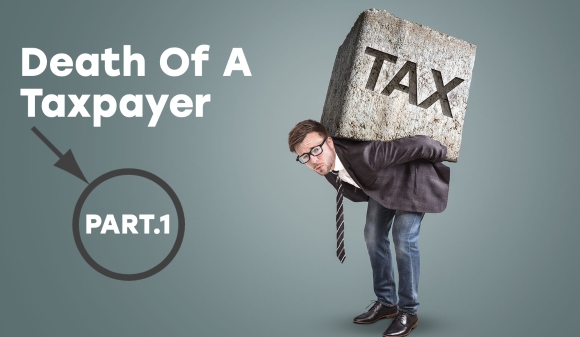Death of a Taxpayer – Part One

 Nine years ago, MoneySaver published Brian’s four-part article dealing with the death of a taxpayer. In this edition, we begin the running of an updated version of the article.
Nine years ago, MoneySaver published Brian’s four-part article dealing with the death of a taxpayer. In this edition, we begin the running of an updated version of the article.
Lana, Editor-in-Chief
This is the first article that will present the income tax implications of the death of a taxpayer. Part two will present the special income tax rules for paying a deceased taxpayer’s income tax liability as well as capital loss utilization in the year of death, part three will deal with the mandatory and optional separate personal income tax returns that can be filed for a deceased taxpayer and part four looks at strategies to minimize the income tax due on death.
Implications Of The Death Of A Taxpayer
At death, a taxpayer may own;
- marketable securities (shares of public companies, mutual funds, etc.) directly,
- marketable securities through a Registered Retirement Savings Plan (RRSP), Registered Retirement Income Fund (RRIF) or Tax-Free Savings Account (TFSA),
- shares of a private corporation (perhaps a family business),
- rental properties,
- family-use properties (home, cottage) and,
- personal-use property such as a car, boat, art, and jewelry.
At death, a taxpayer is considered to have sold all their assets (not held in a RRSP, RRIF or TFSA) at a price equal to the market value at the time. In other words, the deceased has a deemed sale (or deemed disposition) of all their assets. 50% of the resulting net capital gains (capital gains in excess of permitted capital losses) are taxable in the final personal income tax return of the deceased.
When the deceased has a RRSP or RRIF these plans are de-registered on death resulting in 100% of the value at the time of death being taxable—again, on the deceased’s final personal income tax return. Assets held in a TFSA at the time of death remain tax-free to the deceased.
An important exception to the above income tax rules is when assets, including RRSPs and RRIFs, are passed on death to the deceased’s surviving spouse. (For income tax purposes, spouse includes a common-law partner). When this is the case, no income tax will arise on the death of the first spouse. The surviving spouse will not have an income tax liability until the later of ;
- a sale of an inherited asset or a withdrawal from an RRSP or RRIF received from the deceased spouse and
- the surviving spouse’s death.
Investments In Marketable Securities
As with an actual sale of a marketable security not held within a RRSP, RRIF or TFSA, it is important to ensure the capital gain or capital loss is calculated correctly in reporting the deemed sale. Obtaining the value of a publicly traded security at the time of death is not difficult, so the focus is on ensuring the tax cost (the adjusted cost base) of the security is not understated. Common errors in calculating the tax cost of a security are:
- Omitting the increase in the tax cost where the deceased taxpayer made the February 22, 1994 capital gains election as the $100,000 capital gains exemption was phased out.
- Ignoring annual non-cash mutual fund income and capital gain allocations which increase the tax cost of mutual fund investments.
- Not correctly adjusting for stock splits and corporate “spin-offs”.
- Failing to include acquisition commissions in the tax cost.
Rental Properties
With respect to the deemed sale of rental properties owned at death, a capital gain or loss can be separately triggered on the land and building portions of the property.
Capital Gains And Losses
If the value of the land and building portions at the time of death are greater than the respective tax cost of each, there will be a capital gain subject to income tax on both portions.
If the land portion value at the time of death is below the tax cost, then a capital loss may be claimed on the land portion. Land is considered a non-depreciable capital property for income tax purposes. Capital losses can be claimed on non-depreciable capital property.
However, if the building portion’s value at death is less than its tax cost, a capital loss on the building portion is not permitted. Capital losses on depreciable capital property cannot be claimed. However, a terminal loss may be available.
Recapture And Terminal Loss
With respect to the building portion, the deceased is exposed to recapture of past income tax deductions of Capital Cost Allowance (CCA or tax depreciation) claimed. Recapture, or tax depreciation reversal, will occur when the value of the building on death is greater than the depreciated value of the building as calculated on an income tax basis. The depreciated value for income tax purposes is referred to as the undepreciated capital cost or UCC.
In this case, the income tax provisions imply that the economic loss on the building ended up being less than the aggregate of past depreciation claims. Therefore, some or all the past depreciation claims were not warranted. As past depreciation/CCA claims were 100% income tax deductible the recapture of these claims is 100% taxable.
If the building portion has decreased to a value that is below the undepreciated capital cost value, then a terminal loss may be claimed. This is “negative recapture” and is 100% income tax deductible.
Family-use Properties
With respect to family-use properties such as a home and a cottage, the deceased can make use of the principal residence exemption to shelter all or a portion of the accrued capital gain on these properties.
Prior to 1982, it was possible for two residences in a family to qualify for the principal residence exemption. Income tax planning then was to have one spouse own the city home and the other spouse to own the cottage. Sine 1981 only one family-use property is eligible for the principal residence exemption. So, where there is more than one property in a family, it is necessary to decide how best to use the principal residence exemption. This decision will be based on the amount of the accrued gain on each property at the time of death, the number of years each property was owned, the past use of the principal residence exemption by the deceased and his or her spouse and the anticipated increase in value of the properties to occur after the death. If there is an accrued loss on family-use property, a capital loss is not permitted to be claimed.
In determining the tax cost of a family-use property that has been held for a long time, the beginning point is the value of the property on January 1, 1972. (There is no income tax on capital gains accrued before 1972.) The tax cost is then increased by improvements made to the property. Also, many taxpayers made use of the February 22, 1994 capital gains election to increase the tax cost of a family-use property. This was usually done in respect of the family’s cottage as it was expected that the principal residence exemption would be used on the sale, or deemed sale on death, of the family’s city home.
Prior to 2016, where a capital gain on a residence—whether it be an actual sale or a deemed sale on death—was fully sheltered from income tax by the principal residence exemption, it was not necessary to report the capital gain and the principal residence exemption claim on a personal income tax return. It is now necessary to disclose details of the sale, or deemed sale on death, and the use of the principal residence exemption on a personal income tax return.
Avoiding Income Tax On Rrsps And Rrifs At Death
The deceased will not be subject to income tax on the value of their RRSP or RRIF on death to the extent the RRSP or RRIF proceeds are transferred to;
- a surviving spouse,
- a financially dependent child or grandchild or
- a Registered Disability Savings Plan (RDSP) of a financially dependent child or grandchild.
When the beneficiary of an RRSP or RRIF is a financially dependent child or grandchild of the deceased, the value of the RRSP or RRIF is taxed in the hands of the dependent rather than the deceased. If the child or grandchild is under 18, the tax can be spread over the number of years remaining until the child is 18 with the purchase of an annuity.
If the financial dependency is due to a physical or mental disability, the dependent of any age can avoid being immediately taxed on the RRSP or RRIF proceeds by making a transfer to their own RRSP or RRIF or using the funds to purchase an annuity. Income tax is then only paid by the dependent as withdrawals are made from the RRSP or RRIF or when an annuity payment is received.
A deceased taxpayer can also avoid income tax on the value of an RRSP or RRIF at death where the proceeds are transferred to a RDSP of a financially dependent child or grandchild. The amount transferred to the RDSP cannot cause the beneficiary’s maximum RDSP contribution room of $200,000 to be exceeded and no Canada Disability Savings Grant is paid on the transfer. The beneficiary of the RDSP will pay income tax as amounts are taken out of the RDSP.
A child or grandchild is considered financially dependent when they lived with the deceased and their income did not exceed $13,808 (2021) or $22,470 (2021) where the child or grandchild is disabled. Where the child or grandchild’s income exceeds the respective threshold, an argument can be made to Canada Revenue Agency (CRA) to support that the child or grandchild is financially dependent despite their income level.
Personal-use Property
Capital gains resulting from the deemed sale of personal-use property, e.g., cars and boats, like any asset, are subject to income tax on death. If there are accrued losses, the capital losses are not permitted to be claimed. A capital loss on one personal-use asset cannot be used to offset a capital gain on another personal-use asset.
An exception deals with personal-use property that is “listed personal property”: art, jewelry, rare books, stamps, and coins. Capital losses are permitted to be claimed on listed personal property assets but only to the extent they offset any capital gains on other listed personal property.
The minimum value to use in calculating the gains and losses on personal-use property for both the deemed market value at time of death and the tax cost is $1,000.
Brian J. Quinlan, CPA, CA, CFP, TEP
Campbell Lawless LLP
Chartered Professional Accountants

